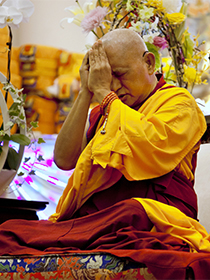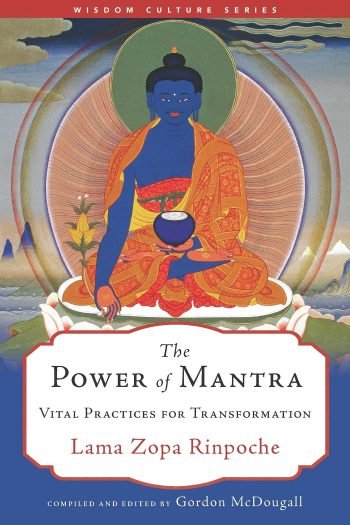- Home
- FPMT Homepage
Foundation for the Preservation of the Mahayana Tradition
The FPMT is an organization devoted to preserving and spreading Mahayana Buddhism worldwide by creating opportunities to listen, reflect, meditate, practice and actualize the unmistaken teachings of the Buddha and based on that experience spreading the Dharma to sentient beings. We provide integrated education through which people’s minds and hearts can be transformed into their highest potential for the benefit of others, inspired by an attitude of universal responsibility and service. We are committed to creating harmonious environments and helping all beings develop their full potential of infinite wisdom and compassion. Our organization is based on the Buddhist tradition of Lama Tsongkhapa of Tibet as taught to us by our founders Lama Thubten Yeshe and Lama Thubten Zopa Rinpoche.
- Willkommen
Die Stiftung zur Erhaltung der Mahayana Tradition (FPMT) ist eine Organisation, die sich weltweit für die Erhaltung und Verbreitung des Mahayana-Buddhismus einsetzt, indem sie Möglichkeiten schafft, den makellosen Lehren des Buddha zuzuhören, über sie zur reflektieren und zu meditieren und auf der Grundlage dieser Erfahrung das Dharma unter den Lebewesen zu verbreiten.
Wir bieten integrierte Schulungswege an, durch denen der Geist und das Herz der Menschen in ihr höchstes Potential verwandelt werden zum Wohl der anderen – inspiriert durch eine Haltung der universellen Verantwortung und dem Wunsch zu dienen. Wir haben uns verpflichtet, harmonische Umgebungen zu schaffen und allen Wesen zu helfen, ihr volles Potenzial unendlicher Weisheit und grenzenlosen Mitgefühls zu verwirklichen.
Unsere Organisation basiert auf der buddhistischen Tradition von Lama Tsongkhapa von Tibet, so wie sie uns von unseren Gründern Lama Thubten Yeshe und Lama Thubten Zopa Rinpoche gelehrt wird.
- Bienvenidos
La Fundación para la preservación de la tradición Mahayana (FPMT) es una organización que se dedica a preservar y difundir el budismo Mahayana en todo el mundo, creando oportunidades para escuchar, reflexionar, meditar, practicar y actualizar las enseñanzas inconfundibles de Buda y en base a esa experiencia difundir el Dharma a los seres.
Proporcionamos una educación integrada a través de la cual las mentes y los corazones de las personas se pueden transformar en su mayor potencial para el beneficio de los demás, inspirados por una actitud de responsabilidad y servicio universales. Estamos comprometidos a crear ambientes armoniosos y ayudar a todos los seres a desarrollar todo su potencial de infinita sabiduría y compasión.
Nuestra organización se basa en la tradición budista de Lama Tsongkhapa del Tíbet como nos lo enseñaron nuestros fundadores Lama Thubten Yeshe y Lama Zopa Rinpoche.
A continuación puede ver una lista de los centros y sus páginas web en su lengua preferida.
- Bienvenue
L’organisation de la FPMT a pour vocation la préservation et la diffusion du bouddhisme du mahayana dans le monde entier. Elle offre l’opportunité d’écouter, de réfléchir, de méditer, de pratiquer et de réaliser les enseignements excellents du Bouddha, pour ensuite transmettre le Dharma à tous les êtres. Nous proposons une formation intégrée grâce à laquelle le cœur et l’esprit de chacun peuvent accomplir leur potentiel le plus élevé pour le bien d’autrui, inspirés par le sens du service et une responsabilité universelle. Nous nous engageons à créer un environnement harmonieux et à aider tous les êtres à épanouir leur potentiel illimité de compassion et de sagesse. Notre organisation s’appuie sur la tradition guéloukpa de Lama Tsongkhapa du Tibet, telle qu’elle a été enseignée par nos fondateurs Lama Thoubtèn Yéshé et Lama Zopa Rinpoché.
Visitez le site de notre Editions Mahayana pour les traductions, conseils et nouvelles du Bureau international en français.
Voici une liste de centres et de leurs sites dans votre langue préférée
- Benvenuto
L’FPMT è un organizzazione il cui scopo è preservare e diffondere il Buddhismo Mahayana nel mondo, creando occasioni di ascolto, riflessione, meditazione e pratica dei perfetti insegnamenti del Buddha, al fine di attualizzare e diffondere il Dharma fra tutti gli esseri senzienti.
Offriamo un’educazione integrata, che può trasformare la mente e i cuori delle persone nel loro massimo potenziale, per il beneficio di tutti gli esseri, ispirati da un’attitudine di responsabilità universale e di servizio.
Il nostro obiettivo è quello di creare contesti armoniosi e aiutare tutti gli esseri a sviluppare in modo completo le proprie potenzialità di infinita saggezza e compassione.
La nostra organizzazione si basa sulla tradizione buddhista di Lama Tsongkhapa del Tibet, così come ci è stata insegnata dai nostri fondatori Lama Thubten Yeshe e Lama Zopa Rinpoche.
Di seguito potete trovare un elenco dei centri e dei loro siti nella lingua da voi prescelta.
- 欢迎 / 歡迎
简体中文
“护持大乘法脉基金会”( 英文简称:FPMT。全名:Foundation for the Preservation of the Mahayana Tradition) 是一个致力于护持和弘扬大乘佛法的国际佛教组织。我们提供听闻,思维,禅修,修行和实证佛陀无误教法的机会,以便让一切众生都能够享受佛法的指引和滋润。
我们全力创造和谐融洽的环境, 为人们提供解行并重的完整佛法教育,以便启发内在的环宇悲心及责任心,并开发内心所蕴藏的巨大潜能 — 无限的智慧与悲心 — 以便利益和服务一切有情。
FPMT的创办人是图腾耶喜喇嘛和喇嘛梭巴仁波切。我们所修习的是由两位上师所教导的,西藏喀巴大师的佛法传承。
繁體中文
護持大乘法脈基金會”( 英文簡稱:FPMT。全名:Found
ation for the Preservation of the Mahayana Tradition ) 是一個致力於護持和弘揚大乘佛法的國際佛教組織。我們提供聽聞, 思維,禪修,修行和實證佛陀無誤教法的機會,以便讓一切眾生都能 夠享受佛法的指引和滋潤。 我們全力創造和諧融洽的環境,
為人們提供解行並重的完整佛法教育,以便啟發內在的環宇悲心及責 任心,並開發內心所蘊藏的巨大潛能 — 無限的智慧與悲心 – – 以便利益和服務一切有情。 FPMT的創辦人是圖騰耶喜喇嘛和喇嘛梭巴仁波切。
我們所修習的是由兩位上師所教導的,西藏喀巴大師的佛法傳承。 察看道场信息:
- FPMT Homepage
- News/Media
-
- Study & Practice
-
-
- About FPMT Education Services
- Latest News
- Programs
- New to Buddhism?
- Buddhist Mind Science: Activating Your Potential
- Heart Advice for Death and Dying
- Discovering Buddhism
- Living in the Path
- Exploring Buddhism
- FPMT Basic Program
- FPMT Masters Program
- FPMT In-Depth Meditation Training
- Maitripa College
- Lotsawa Rinchen Zangpo Translator Program
- Universal Education for Compassion & Wisdom
- Online Learning Center
-
- Prayers & Practice Materials
- Overview of Prayers & Practices
- Full Catalogue of Prayers & Practice Materials
- Explore Popular Topics
- Benefiting Animals
- Chenrezig Resources
- Death & Dying Resources
- Lama Chopa (Guru Puja)
- Lama Zopa Rinpoche: Compendium of Precious Instructions
- Lama Zopa Rinpoche: Life Practice Advice
- Lama Zopa Rinpoche Practice Series
- Lamrim Resources
- Mantras
- Prayer Book Updates
- Purification Practices
- Sutras
- Thought Transformation (Lojong)
- Audio Materials
- Dharma Dates - Tibetan Calendar
- Translation Services
- Publishing Services
- Ways to Offer Support
- Prayers & Practice Materials
-
- Teachings and Advice
- Find Teachings and Advice
- Lama Zopa Rinpoche Advice Page
- Lama Zopa Rinpoche: Compendium of Precious Instructions
- Lama Zopa Rinpoche Video Teachings
- ༧སྐྱབས་རྗེ་བཟོད་པ་རིན་པོ་ཆེ་མཆོག་ནས་སྩལ་བའི་བཀའ་སློབ་བརྙན་འཕྲིན།
- Podcasts
- Lama Yeshe Wisdom Archive
- Buddhism FAQ
- Dharma for Young People
- Resources on Holy Objects
- Teachings and Advice
-
-
*If a menu item has a submenu clicking once will expand the menu clicking twice will open the page.
-
-
- Centers
-
- Teachers
-
- Projects
-
-
-
-
*If a menu item has a submenu clicking once will expand the menu clicking twice will open the page.
-
-
- FPMT
-
-
-
-
-
Without understanding how your inner nature evolves, how can you possibly discover eternal happiness? Where is eternal happiness? It’s not in the sky or in the jungle; you won’t find it in the air or under the ground. Everlasting happiness is within you, within your psyche, your consciousness, your mind. That’s why it’s important that you investigate the nature of your own mind.
Lama Thubten Yeshe
-
-
-
- Shop
-
-
-
The Foundation Store is FPMT’s online shop and features a vast selection of Buddhist study and practice materials written or recommended by our lineage gurus. These items include homestudy programs, prayers and practices in PDF or eBook format, materials for children, and other resources to support practitioners.
Items displayed in the shop are made available for Dharma practice and educational purposes, and never for the purpose of profiting from their sale. Please read FPMT Foundation Store Policy Regarding Dharma Items for more information.
-
-
Advice from Lama Zopa Rinpoche
1
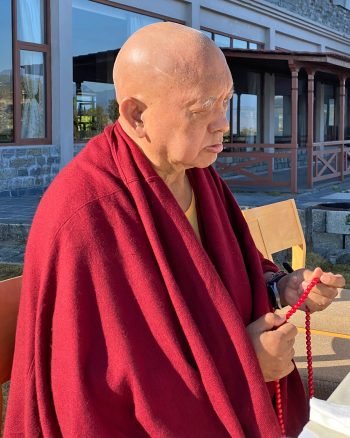
Lama Zopa Rinpoche in Pokhara, Nepal, December 2021. Photo by Ven. Roger Kunsang.
Our time to practice Dharma is fleeting. Lama Zopa Rinpoche encourages students to meditate on impermanence and death so that instead of just listening to Dharma, we put the teachings of the Buddha into practice.
Here is a short summary of Rinpoche’s teachings on impermanence and death from “The Time to Practice is Now,” a detailed overview of the 2020 Thought Transformation Teachings given by Rinpoche. A short video of Rinpoche teaching on this topic follows the excerpt.
Rinpoche explains that all the teachings of the Buddha are to subdue our minds. However, for the teachings to do that, we first need to meditate on impermanence and death. Without remembering impermanence and death we will listen to teachings, such as those on lojong, and even think that they are nice, but we won’t put them into practice. Instead we will put them away in a box, intending to keep them for later. But because we have no idea when we are actually going to die (and indeed we are running toward death all the time), we don’t have the luxury of waiting until we are old to start practicing. The time is now. Unlike other subjects in Buddhism, the subject of death and impermanence is easy to understand. At the same time, it is incredibly important! We must think about it from the depths of our hearts because without continually remembering death and impermanence we won’t achieve realizations and complete the path to enlightenment.
When we don’t think of death, our mind becomes totally distracted by the outside five sense objects, the pleasures of this life, as well as by our friends and enemies. All of our hard work is for this life’s happiness only, and nothing we do becomes holy Dharma. All the mistakes we make, especially in terms of wasting our life, happen due to not having an awareness of death and impermanence. As long as we are still clinging to the happiness of this life, we won’t practice holy Dharma. Our actions become only worldly dharma, non-virtue. Giving up the attachment clinging to the happiness of this life is the very first Dharma practice. This is achieved by remembering death and impermanence.
If we think of our death—if we remember that our death can happen this year, this month, this week, even today—it brings our mind inside, and we examine our own life. We come to realize that there is no point in being attached to our wealth and other objects of desire. Since we have to leave everything behind, why be attached to dream-like objects of desire?
Since beginningless rebirths we have been harming others due to attachment and desire. Our mind has cheated us by following attachment and by using everything, including our body, merits, possessions, and other people, in the wrong way—to create suffering instead of happiness. But remembering death stops the delusions—such as anger, attachment, ignorance, and self-cherishing—from arising and stops us from engaging in negative karma.
At the time of death, there is no more time to think about and transform our minds. When our whole life has been under the control of the self-cherishing thought and attachment to this life, at the time of death we will see that we have not only wasted this precious human life, but our actions have been negative.
Therefore, thinking about death and being afraid of the suffering in samsara is so useful to a Dharma practitioner. It makes us practice Dharma sincerely in order to become free from the oceans of samsaric sufferings and lower nirvana, and to achieve great nirvana, or enlightenment, in order to be able to free the numberless sentient beings from the oceans of samsaric sufferings and bring them to enlightenment.
Watch the Essential Extract “Without Remembering Impermanence-death, You Won’t Practice Lojong”:
In this Essential Extract, Lama Zopa Rinpoche explains that all the teachings of the Buddha are to subdue our minds. However, for the teachings to do that, we first need to meditate on impermanence-death. Without remembering impermanence-death we will listen to teachings, such as those on lojong, and even think that they are nice, but we won’t put them into practice. Instead we will put them away in a box!
Read the transcript of this video extract from Rinpoche’s teaching:
https://fpmt.box.com/s/ysiv9518wtflh7uqd78kqgvp05w4q5i5
You can find more blogs with short video clips from Rinpoche’s teaching as well as the complete collection of these “Essential Extracts” videos on FPMT.org.
Lama Zopa Rinpoche is the spiritual director of the Foundation for the Preservation of Mahayana Tradition (FPMT), a Tibetan Buddhist organization dedicated to the transmission of the Mahayana Buddhist tradition and values worldwide through teaching, meditation and community service.
- Tagged: advice from lama zopa rinpoche, death and dying, essential extract, essential extract thought transformation teachings, impermanence and death, video
29
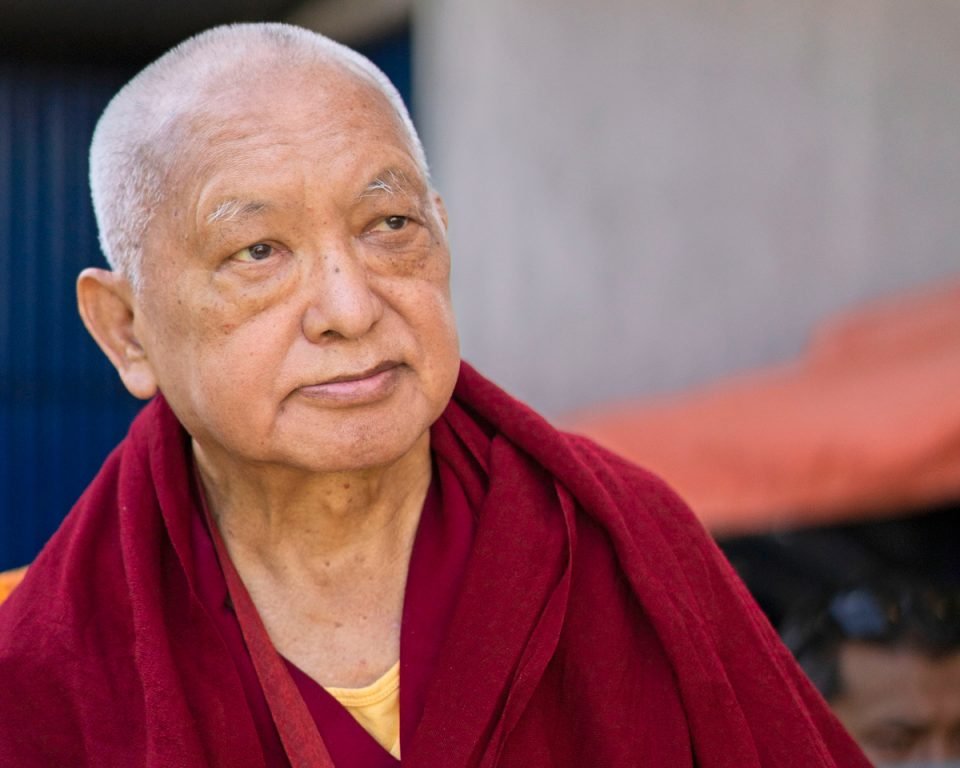
Lama Zopa Rinpoche during a visit to the Dickey Tsering Children’s Home in Kathmandu, Nepal, November 2021. Photo by Ven. Lobsang Sherab.
The Six Perfections: The Practice of the Bodhisattvas (2020) by Lama Zopa Rinpoche has been recently released in a paperback edition. In the book, Rinpoche walks us through the six perfections, which are a key Mahayana Buddhist teaching. Here’s an excerpt from Rinpoche’s teaching on the perfection of charity:
Keeping our mind pure—free from pride, miserliness, and so forth—is very difficult for ordinary people like us. If we could give simply, without all these disturbing thoughts clouding our giving, our generosity would be perfect and attaining another perfect human rebirth would be easy. But this is a struggle for most of us. That is why we must always check our motivation and be diligent in observing our karma.
The villagers of Solu Khumbu, where I was born, have a very good custom to protect themselves and others. Because they are incredibly poor, theft is always a problem. Things are often stolen: cooking pots, money—even potatoes. In many villages the people bury pots of their precious potatoes outside to keep them safe, but thieves can generally guess where the pots are buried, and they dig them up. Also, sometimes people borrow things and don’t return them, no matter how much the owner complains and shouts.
In such cases of theft, the villagers often go to a monastery and ask the lama there to say prayers and dedicate the merit of the prayer to the thief, totally offering them that thing. Whether or not this becomes a virtuous act does not depend on the lama but on the mind of the victim. If the person can renounce the stolen object completely and offer it to the thief with compassion, then it is virtuous. The owner needs the object, but the thief also needs it, and so by renouncing it and offering it to the thief with compassion, the dedication becomes a virtuous action.
If somebody stole a hundred dollars from us and we cannot do the practice of dedication—if we cannot take the loss upon ourselves and offer the victory to that sentient being; if we still cling to that hundred dollars—how can we perfect the practice of charity? Even without considering how kind that sentient being has been, how precious they are, we should rejoice that they needed something and now they have it. Like us, they want happiness and do not want suffering—in that way they are completely equal to us—so why can’t they have that hundred dollars? If we were to find a hundred dollars, how happy we would be. If we were to find a thousand dollars or a million dollars, we would be so surprised and excited. We would clap our hands with joy. So why can’t we do the same thing for this sentient being who has come across a hundred dollars?
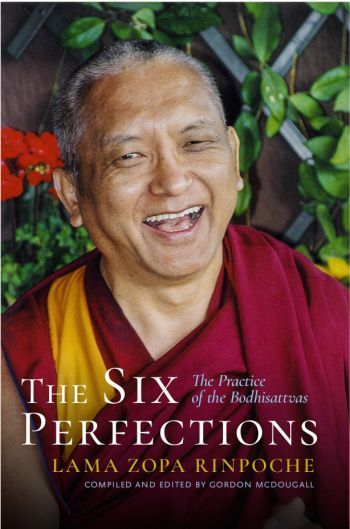
Cover of Lama Zopa Rinpoche’s book The Six Perfections
Learn more about The Six Perfections: The Practice of the Bodhisattvas, including order information, on Wisdom Publication’s website:
https://wisdomexperience.org/product/the-six-perfections/
The Six Perfections is also available as an e-book from the Foundation Store.
Watch the video series Lama Zopa Rinpoche’s Teachings on Thought Transformation and find links to videos in translation, transcripts, MP3s, additional practice advice, and more.
Lama Zopa Rinpoche is the spiritual director of the Foundation for the Preservation of Mahayana Tradition (FPMT), a Tibetan Buddhist organization dedicated to the transmission of the Mahayana Buddhist tradition and values worldwide through teaching, meditation and community service.
- Tagged: charity, lama zopa rinpoche, wisdom publications
24
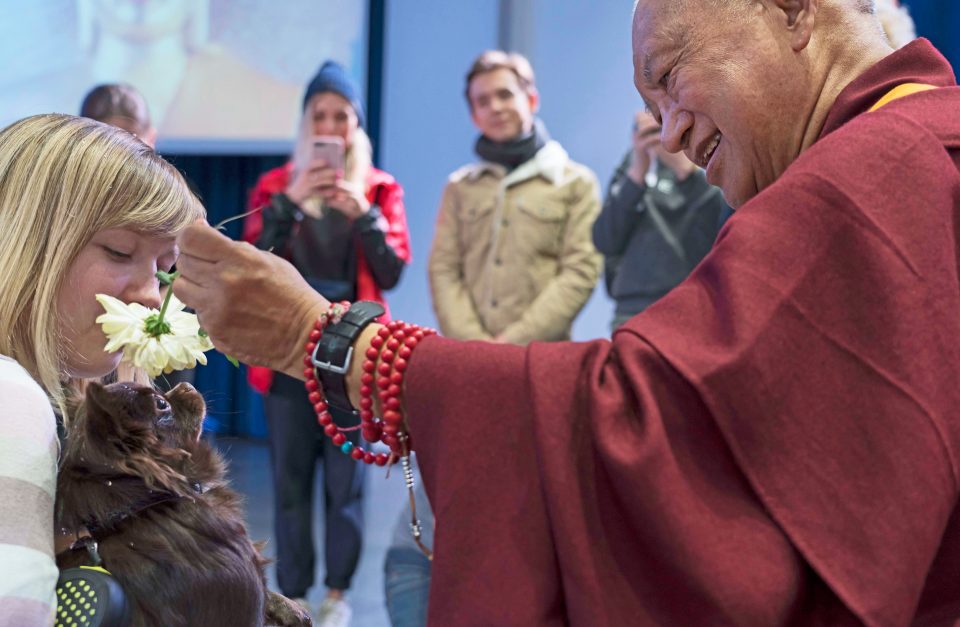
Lama Zopa Rinpoche blessing a dog at an animal blessing in Moscow, Russia, 2019. Photo by Ven. Lobsang Sherab.
The following video is an Essential Extract from Lama Zopa Rinpoche. Essential Extracts are short videos extracted from a longer teachings that focus on a specific topic. We have more than two hundred Essential Extract videos available on our website. We also routinely share these Essential Extract videos in blog posts, which include transcripts and links to additional materials. Here is a short Essential Extract on the importance of providing Dharma imprints for our pets.
In this video, Lama Zopa Rinpoche tells a story about a dog from Tushita Meditation Centre in Dharamsala that he gave to a woman in Delhi. Rinpoche asked her to recite a lamrim prayer and mantra to the dog, which she did. Rinpoche praises her so much for doing this every day. Hearing the prayers saves the dog from the lower realms, frees it from samsara, and brings it to enlightenment. Therefore, this is also what we need to do for our own beloved pets!
Watch the Essential Extract “Just Giving Food and Shelter to Our Pets Is Not Enough”:
Read the transcript of this video extract from Rinpoche’s teaching:
https://fpmt.box.com/s/rair1ijp8zlrwui3nuw7afcwhdc2p0oi
Find more advice and resources for helping pets on our Benefiting Animals page:
https://fpmt.org/education/prayers-and-practice-materials/benefiting-animals-practices-and-advice/
You can find more blogs with short video clips from Rinpoche’s teaching as well as the complete collection of these “Essential Extracts” videos on FPMT.org.
Lama Zopa Rinpoche is the spiritual director of the Foundation for the Preservation of Mahayana Tradition (FPMT), a Tibetan Buddhist organization dedicated to the transmission of the Mahayana Buddhist tradition and values worldwide through teaching, meditation and community service.
- Tagged: advice from lama zopa rinpoche, animals, essential extract, essential extract thought transformation teachings, taking care of animals, video
22
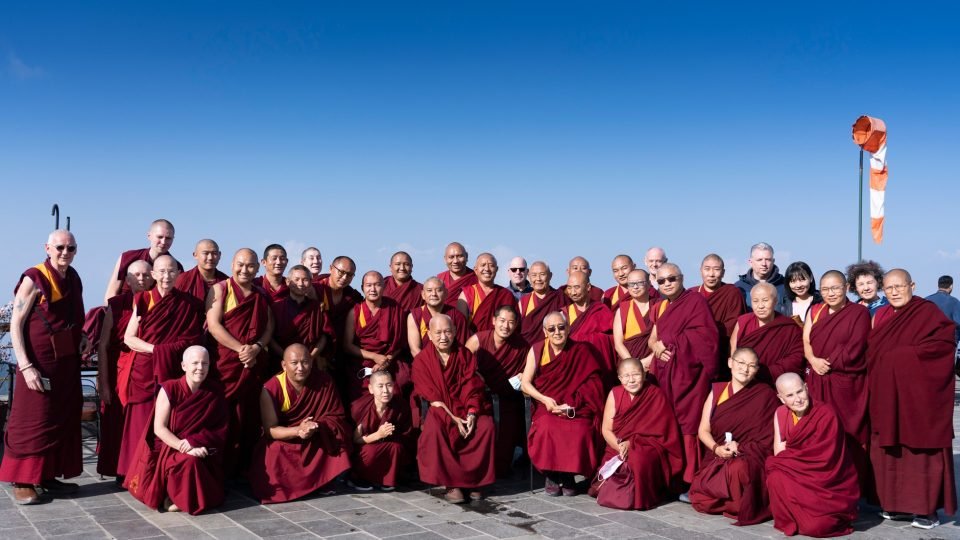
Lama Zopa Rinpoche with the geshes and geshemas who teach philosophy at Kopan Monastery and Nunnery, senior nuns, some Kopan staff, and a few lay students at the Chandragiri Hill Resort, Nepal, November 2021. Photo by Ven. Lobsang Sherab.
The following video is an Essential Extract from Lama Zopa Rinpoche. Essential Extracts are short videos extracted from longer teachings that focuses on a specific topic. We have more than two hundred Essential Extract videos available on our website. We also routinely share these Essential Extract videos in blog posts, which include transcripts and links to additional materials. Here is a short Essential Extract on the bravery of ordained sangha.
In this video, Lama Zopa Rinpoche explains how ordained monks and nuns, the sangha, are real heroes. They are incredibly brave because they are conquering the delusions that have kept us in samsara from beginningless rebirths. Each sangha member has been a hero for however many years, months, and weeks they have been ordained.
Rinpoche explains that the numberless buddhas and bodhisattvas are happy with us for conquering delusions and are helping us, but we have to do the work. We have to recognize that delusion is the real enemy. Delusion has been defeating us from beginningless rebirths, but now we defeat delusion! That is Dharma practice. That is real Dharma.
Watch the video “The Sangha Are Real Heroes Because They Are Defeating Delusion”:
Read the transcript of Rinpoche’s teaching:
https://fpmt.box.com/s/il1h3stjbenp9uzxm7t8n10xj1wgzb6z
Learn more about FPMT ordained sangha:
https://fpmt.org/centers/sangha/
The above video is extracted from the Thought Transformation Teaching video recorded on July 12, 2020, at Kopan Monastery in Nepal. You can find more blogs with short video clips from Rinpoche’s teaching as well as the complete collection of these “Essential Extracts” videos on FPMT.org.
Watch videos from the series Lama Zopa Rinpoche’s Teachings on Thought Transformation and find links to transcripts, MP3s, additional practice advice, and more. Read an in-depth summary of Rinpoche’s thought transformation teachings given in 2020 in the Mandala 2021 article “The Time to Practice Is Now.”
Lama Zopa Rinpoche is the spiritual director of the Foundation for the Preservation of Mahayana Tradition (FPMT), a Tibetan Buddhist organization dedicated to the transmission of the Mahayana Buddhist tradition and values worldwide through teaching, meditation and community service.
- Tagged: advice from lama zopa rinpoche, essential extract, essential extract thought transformation teachings, sangha, video
11
The Karma of Killing
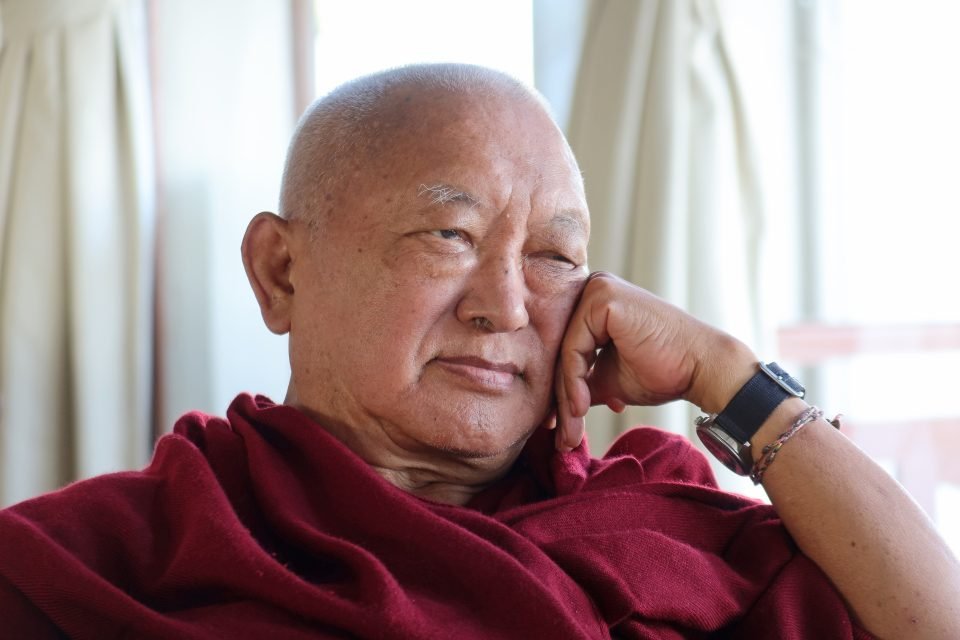
Lama Zopa Rinpoche, Pokhara, Nepal, December 2021. Photo by Ven. Roger Kunsang.
The following video is an Essential Extract from Lama Zopa Rinpoche. Essential Extracts are short videos extracted from a longer teachings that focuses on a specific topic. We have more than two hundred Essential Extract videos available on our website. We also routinely share these Essential Extract videos in blog posts, which include transcripts and links to additional materials. Here is a short Essential Extract on the karma of killing.
In this short video, Lama Zopa Rinpoche comments on how sad it is that there are children who kill snakes to make a living. Rinpoche reminds us that anyone who kills even one sentient being, will have to experience the four suffering karmic results of killing.
Rinpoche explains the karmic results of killing in the following way:
- The complete negative karma of killing a snake has the ripened-aspect result of rebirth in hell, in the lower realms.
- The possessed result is that even when good karma ripens and you are reborn as a human being, you still suffer and have many problems in life, including dangers of death, because of killing a snake. You live in places where there are a lot of contagious diseases, obstacles to your health, and so forth.
- There is experiencing the result similar to the cause. This is when others kill you as the result of the past karma of killing the snake.
- There is creating the result similar to the cause. As a result of the past negative karma of killing a snake, even if it was just once, you want to kill again. You created a habit for killing. Then when you kill again, the negative karma created has the four suffering results again. So it goes on and on, on and on. It makes endless suffering of samsara.
Lama Zopa Rinpoche stresses how it is therefore sooooooo important and even urgent to abandon committing the ten non-virtues, including killing, and to practice Dharma.
Watch the video “Karma of Children Who Kill Snakes”:
Read the transcript of Rinpoche’s teaching:
https://fpmt.box.com/s/3e5nqxh8s39xs8nfstae1cv4km2z5e07
The above video is extracted from a Thought Transformation Teaching video recorded on December 9, 2020, at Kopan Monastery in Nepal. You can find more blogs with short video clips from Rinpoche’s teaching as well as the complete collection of these “Essential Extracts” videos on FPMT.org.
Watch videos from the series Lama Zopa Rinpoche’s Teachings on Thought Transformation and find links to transcripts, MP3s, additional practice advice, and more. Read an in-depth summary of Rinpoche’s thought transformation teachings given in 2020 in the Mandala 2021 article “The Time to Practice Is Now.”
Lama Zopa Rinpoche is the spiritual director of the Foundation for the Preservation of Mahayana Tradition (FPMT), a Tibetan Buddhist organization dedicated to the transmission of the Mahayana Buddhist tradition and values worldwide through teaching, meditation and community service.
- Tagged: advice from lama zopa rinpoche, essential extract, essential extract thought transformation teachings, karma, video
8
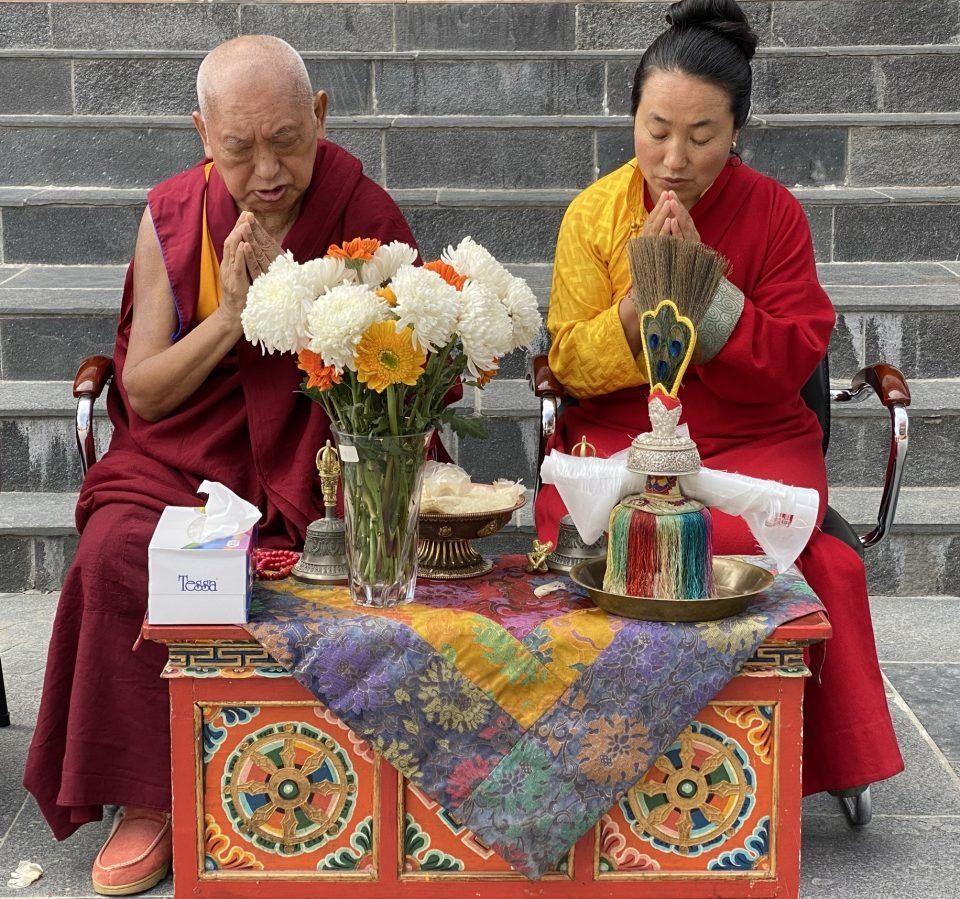
Lama Zopa Rinpoche and Khadro-la during the consecration of large appliqué Twenty-one Taras thangkas and the Eight Taras That Save from Fear thangkas outside Kopan Gompa, Kopan Monastery, Nepal, January 2021. Photo by Ven. Roger Kunsang.
In the new book The Power of Mantra: Vital Practices for Transformation, Lama Zopa Rinpoche guides students through understanding the power and benefit of mantras. Rinpoche explains many popular mantras, giving specific instructions for practicing them, including Shakyamuni Buddha, Chenrezig, Manjushri, Tara, Medicine Buddha, Vajrasattva, and more. In an excerpt from the chapter on Tara mantra, Rinpoche discusses Mother Tara:
The benefits of practicing Tara are uncountable. By reciting the Praises to the Twenty-One Taras with devotion, at dawn or dusk, and remembering Tara and reciting her mantra at any time of the day or night, we are protected from fear and danger, and all our wishes are fulfilled. If we pray to Tara, Tara will grant help quickly.
She is especially quick in granting us success in obtaining the ultimate happiness of enlightenment, but there are also many temporal benefits of reciting the Tara mantra or the Praises to the Twenty-One Taras prayer. Tara can solve many problems in life: liberating us from untimely death, helping us recover from disease, bringing us success in business. Somebody with a serious problem, such as a life-threatening disease, who relies on Tara will very commonly be freed from that problem. For instance, His Holiness the Dalai Lama encouraged us to recite Tara’s mantra as a protection for ourselves and others against the coronavirus COVID-19.
Pabongka Dechen Nyingpo tells a story of one of his students who didn’t know much Dharma but had faith in Tara and so received help from her, but not as much as he might have. One day during his journey to Mongolia, while walking along reciting Tara prayers, he heard a dog barking and saw a tent. Because he needed some water to quench his thirst, he went there, where he saw a young girl, alone, tending many yaks. Seeing the monk was weak and hungry, she insisted he stay with her for a few days and she fed him. When it was time to leave, she gave him some tsampa and other food. Because he was completely lost, she gave him very explicit directions on how to get to his destination and, as he was leaving, she gave him a large bunch of grass. She explained that when he awoke each morning, he should drop some grass on the ground and head in whichever direction it fell.
He only had a little food, enough for a day or two, but each day, when he opened the sack, his food was never depleted. Following the directions the girl had given him, he managed to find his way to his destination. When he looked in his sack at the very end of his journey, there was not one speck of food left. He was so surprised with this that he sent a letter to his guru, Pabongka Rinpoche, in Lhasa. Rinpoche wrote back and said that it was a pity he hadn’t followed the girl’s instructions completely. If he had, he would have been in a pure realm already. That yak herder was a manifestation of Tara, but he was unable to see this. Tara manifests in many aspects, not just the green and white forms that are commonly depicted.
Tara is like our mother. Take my mother as an example. She did all the work while the rest of us—there were three of us—were useless. One day, she had to go into the forest to get the firewood. Because none of us could make food, we waited outside the door for her to return so we could eat. When she came back very late with a very heavy load of firewood, she could not make a fire because she was sick. She lay down next to the fireplace in so much pain. There was no fire in the stove and no food. She was screaming, calling for her mother: “Ama! Ama!” (My grandmother, who was still alive at that time, lived quite near.) Because none of us could make one, there was no fire; we just sat and watched our mother. Even adults call for their mother when they have bad pain or a serious problem. However, Tara is much closer to us than a mother, and she is quick to grant us help and protect us from danger.
The Praises to the Twenty-One Taras begins, “I prostrate to the noble transcendent liberator.” That means that Tara herself is completely liberated from the whole of samsara and the cause of samsara through having completed the both the method and wisdom sides of the practice. Not only that, by having overcome the two obscurations, gross and subtle, she is also free from being bound to lower nirvana. Liberated from both samsara and the peace of lower nirvana means she is fully enlightened. And because she in turn liberates all of us, allowing us to attain full enlightenment, she is called Tara the Liberator, the mother who liberates.
From The Power of Mantra: Vital Practices for Transformation by Lama Zopa Rinpoche; compiled and edited by Gordon McDougall; published by Wisdom Publications (WisdomExperience.org), where you can order the paperback or digital versions of the book. You can also find the ebook and PDF version in the Foundation Store (shop.fpmt.org).
Find more resources for your Tara practice as well as recent advice on mantra practices for His Holiness the Dalai Lama and Lama Zopa Rinpoche on our website (FPMT.org).
Lama Zopa Rinpoche is the spiritual director of the Foundation for the Preservation of Mahayana Tradition (FPMT), a Tibetan Buddhist organization dedicated to the transmission of the Mahayana Buddhist tradition and values worldwide through teaching, meditation and community service.
- Tagged: 21 taras, lama zopa rinpoche, mantra, wisdom publications
25
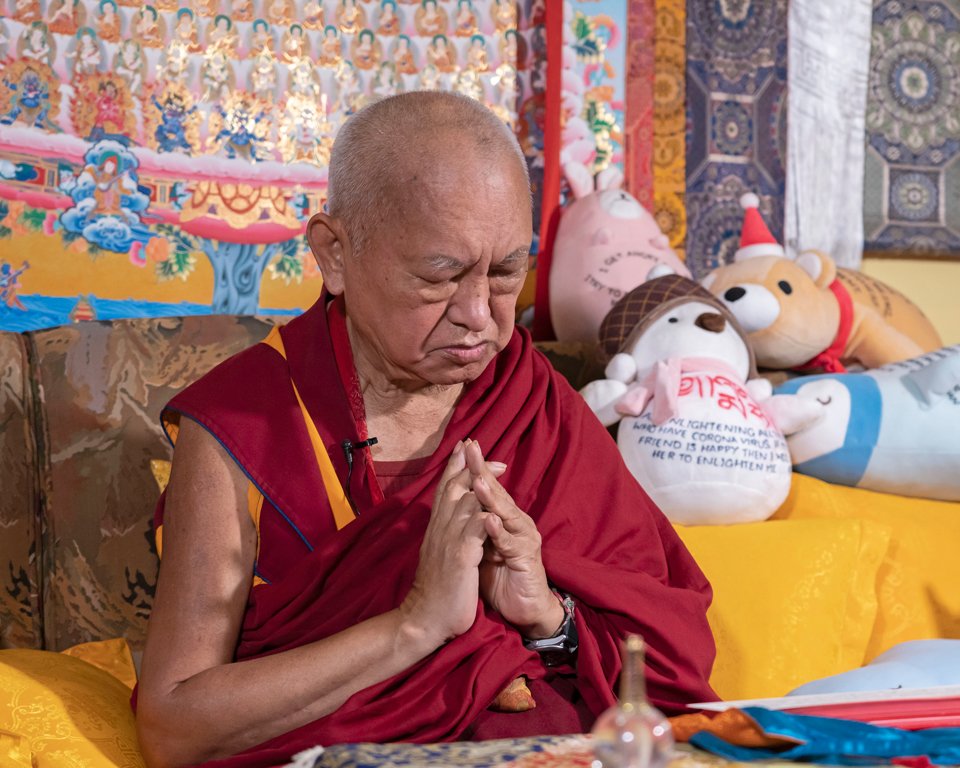
Lama Zopa Rinpoche making prayers, at Kopan Monastery, March 2021. Photo by Ven. Lobsang Sherab.
Lama Zopa Rinpoche has given the following advice regarding practices to do in response to the current situation in Ukraine at this time, to reduce the war and to help stop the violence and suffering. Rinpoche has also already arranged a number of powerful pujas, such as controlling fire puja, wrathful fire pujas, and Drugchuma (Sixty-Four Offerings to Kalarupa).
With a bodhicitta motivation and strong dedication, Rinpoche is advising the following practices:
- Recitation of “Padmasambhava—The Prayer to Guru Rinpoche that Spontaneously Fulfills All Wishes” (Sampa Lhundrupma) | Download
- Recitation of “Padmasambhava—The Supplication to Guru Rinpoche Clearing the Obstacles on the Path” (Barchey Lamsel) | Download
- Recitation of White Umbrella practice
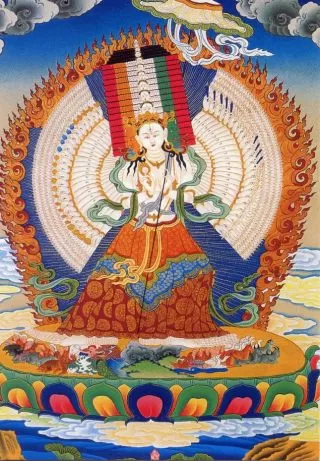
White Umbrella deity.
General Motivation:
The ultimate purpose of my life is to do perfect work for others. In order to fulfill that purpose, it is necessary for me to achieve the state of full enlightenment, omniscient mind, and in order to do that, I must actualize the path to enlightenment. Therefore, I am going to do actions that become only causes for me to achieve enlightenment and to bring all sentient beings to enlightenment as quickly as possible. May all my actions become only causes for me to achieve enlightenment and to bring all sentient beings to enlightenment as quickly as possible.
General Dedications:
To Actualize Bodhicitta
Due to all the past, present, and future merits collected by me and all the merits of the three times collected by numberless buddhas and numberless sentient beings, may bodhicitta be generated in the hearts of all the sentient beings of the six realms, and especially in the hearts of everybody in this world, including all the students, benefactors, and volunteers in the FPMT organization. May it be generated in the hearts of all those who rely upon me, all those for whom I have promised to pray, and all those whose names have been given to me. May it be generated in my heart
For Peace and Happiness to Prevail in the World
Due to all the past, present, and future merits collected by me, the numberless buddhas, and the numberless sentient beings, may all wars—particular the current situation in Ukraine—famines, diseases, global problems, and all dangers of earth, water, fire, and wind be stopped immediately. May perfect peace and happiness prevail in everyone’s hearts by their generating loving kindness, compassion, and bodhicitta. May the Buddhadharma, from where sentient beings receive peace and happiness, last a long time and spread in all directions. May all sentient beings meet the Buddhadharma and achieve enlightenment as quickly as possible.
To Seal the Merits with Emptiness
Due to all the past, present, and future merits collected by me, the numberless buddhas, and the numberless sentient beings, which are completely empty of existing from their own side, may I, who am completely empty of existing from my own side, achieve the state of full enlightenment, which is completely empty of existing from its own side, and lead all sentient beings, who are completely
empty of existing from their own side, to that state, which is completely empty of existing from its own side, by myself alone, who am completely empty of existing from my own side.
To Dedicate in the Same Way as All the Past Buddhas
and Bodhisattvas
I fully dedicate all these virtues
To be able to train just like
The hero Mañjuśrī, who knows reality,
And just like Samantabhadra as well.
I fully dedicate all my roots of virtue,
With the dedication praised as the best
By all the gone-beyond victorious ones of the three times
In order to have good conduct.
Motivation and dedications taken from A Daily Meditation on Shakyamuni Buddha, by Lama Zopa Rinpoche.
Valuable and timely advice from Lama Zopa Rinpoche can be found on Rinpoche’s advice page.
Lama Zopa Rinpoche is the spiritual director of the Foundation for the Preservation of Mahayana Tradition (FPMT), a Tibetan Buddhist organization dedicated to the transmission of the Mahayana Buddhist tradition and values worldwide through teaching, meditation and community service.
24
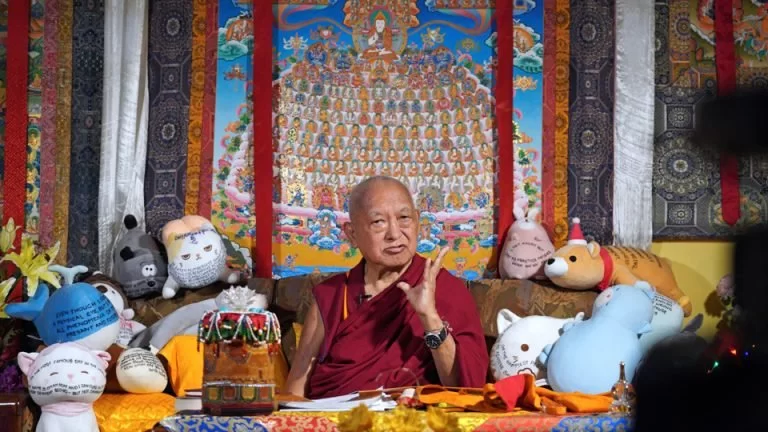
Lama Zopa Rinpoche teaching on make offerings on the anniversary of the guru’s passing away, Kopan Monastery, Nepal, March 2021. Photo by Ven. Lobsang Sherab.
Last year, Lama Zopa Rinpoche translated and commented on a short Tibetan text during his ongoing thought transformation teachings. The text explains the importance of making offerings on the anniversary of the passing away of one’s guru. Rinpoche’s translation and commentary have now been published in the booklet Advice for the Anniversary of the Guru’s Passing Away, available from the Foundation Store.
The new booklet is being offered to inspire students and centers to do practices, such as Lama Chopa with Tsog Offering, on Losar, the Tibetan New Year, in relation to Lama Yeshe, who founded the FPMT organization with his heart disciple Lama Zopa Rinpoche. Losar is of special significance to the FPMT community as it marks the anniversary of the passing of Lama Yeshe.
Rinpoche praised his beloved teacher last year from Kopan Monastery:
“Lama Yeshe, whose holy name is extremely difficult to mention and whose kindness is difficult to express, took the aspect of passing away early in the morning of the first day of the Tibetan New Year (Losar) in 1984. I was with Lama for many years and all the FPMT centers, as well as several schools and hospices, were started by him.
“I have been meaning to explain for some time what to do on the anniversary of Lama Yeshe’s passing away (gong dzog) but it didn’t happen until now. As explained in the text, A Hundred Clear Realizations of the Glorious One from Narthang by Namkha Drag, you should make offerings on that day by, for example, doing Lama Chopa and Tsog Offering. You can also do the same on the anniversary of the passing away of your other lamas, such as Choden Rinpoche and Ribur Rinpoche. Making offerings on the death anniversary of a guru is an incredible practice in that it brings about the greatest purification of negative karma and collects the most extensive merit.”
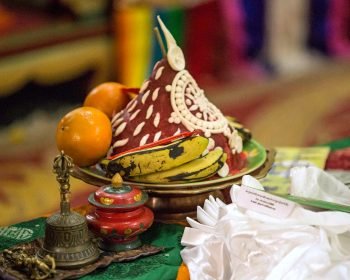
Tsog offering, India, February 2017. Photo by Paola Regis.
Rinpoche’s translation of Advice for the Anniversary of the Guru’s Passing Away sets out the benefits of making offerings, how to make offerings with six remembrances, and how to offer and dedicate the roots of virtue collected. Doing practices such as Lama Chopa with tsog is what is meant by “Making offerings on the anniversary of the guru’s passing away.” In other words, these offerings include offering tsog and are not just setting out a lot of water bowls, flowers, and so forth.
For more on Advice for the Anniversary of the Guru’s Passing Away, please see Rinpoche’s thought transformation teachings “Make Offerings on the Anniversary of Your Guru’s Passing Away” and “Make Offerings Thinking You Are Offering Them to Your Guru’s Pores.”
Rinpoche also recommends introducing new students to Lama Yeshe on Losar and taking time to remember him by watching videos of him teaching and reading stories about his life.
Find Advice for the Anniversary of the Guru’s Passing Away on the Foundation Store:
https://shop.fpmt.org/Advice-for-the-Anniversary-of-the-Gurus-Passing-Away-PDF-_p_3668.html
Find more advice from Lama Zopa Rinpoche on practices to do during Losar and the Fifteen Days of Miracles, please see:
https://fpmt.org/edu-news/practice-advice-and-rejoicing-for-losar-and-the-fifteen-days-of-miracles
Lama Zopa Rinpoche is the spiritual director of the Foundation for the Preservation of Mahayana Tradition (FPMT), a Tibetan Buddhist organization dedicated to the transmission of the Mahayana Buddhist tradition and values worldwide through teaching, meditation and community service.
- Tagged: advice from lama zopa rinpoche, lama chopa, losar, the hundred clear realizations of the glorious one from narthang
17
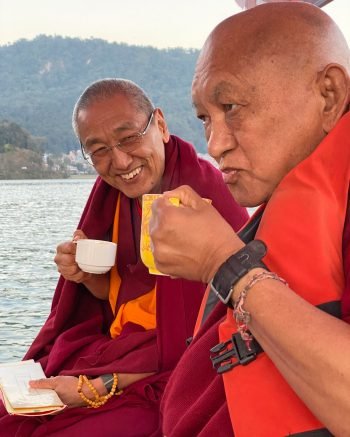
Rinpoche and Khen Rinpoche Geshe Chonyi, enjoying tea on the lake in Pokhara after blessing the sentient beings in the lake, Pokhara, Nepal, December 2021. Photo by Ven. Roger Kunsang.
We can do many things with our perfect human rebirth. Lama Zopa Rinpoche consistently reminds us to not waste this human rebirth but use it to develop compassion and help others. Here is an excerpt of Rinpoche’s teachings on this topic from “The Time to Practice is Now,” a detailed summary of the 2020 Thought Transformation Teachings given by Rinpoche. Then, following the excerpt, is a short video of Rinpoche teaching on this topic.
By reflecting on our own samsara and realizing that we have experienced oceans of suffering from beginningless rebirths, we develop strong renunciation wishing to be free from it. When we also think that others are suffering in the same way, we develop compassion for them, wishing them to be free from suffering. While we are just one, they are numberless—and they suffer just like us. We can’t imagine the different kinds of suffering that other beings experience. It is unbearable.
To generate compassion, we need to know the suffering of the six-realm sentient beings. For example, pretas, or hungry ghosts (a type of being), can’t find food or drink for tens of thousands of years. Due to their karma, even if they see water, their gaze dries the water up and it disappears. If they look at a green plant, it becomes bare and wilted. One type of preta has a mouth the size of the eye of a needle, but a stomach as big as a mountain. Even if they find food or drink, it cannot fill their stomachs. A second type of preta has flames coming from its mouth, and a third type has knots in its neck. These pretas all have unimaginable, unbearable suffering. One practice Rinpoche does often is making charity to these pretas by combining the practice with Dzambala offering, utilizing the offered water for the pretas.
As human beings, we cannot stand even small problems and difficulties. But these hardships are nothing compared to those experienced by animals. They cannot express themselves, so there is no one to help them. In addition, human beings, from presidents and billionaires down to beggars, do not really comprehend the feelings of animals. We kill thousands of animals every day for food. People not only eat them, but also make money from killing them and selling their meat and other body parts including skin and fur. People have the mistaken view that this is a good thing, that there is nothing wrong with it, that these beings are there for our pleasure. They never think about the suffering of the animals and that they also want happiness. They don’t realize that these beings, who have been their mother’s numberless times, are objects of compassion, not simply objects of pleasure.
We, therefore, need to develop compassion for animals and help them. There are many ways to benefit animals, who may suffer in the animal realm not just for this one lifetime, but for many eons. In his teachings, Rinpoche offers examples of how to cherish all sentient beings, including even the tiniest (and most irritating!) among us, such as mosquitoes. Some ideas of ways to benefit them include offering them blessed water or food, reciting prayers and mantras to them, playing sutras for them to hear, taking them around holy objects, and so forth. We can also build holy objects that animals can circumambulate to collect merit.
Wherever we go we can benefit sentient beings. For example, when we go to the beach, we can benefit all the animals in the ocean by dedicating our merits for them to never again be reborn in the lower realms and to be free from physical and mental sufferings, and for all of their wishes to succeed according to holy Dharma. Also, while at the beach, we can pray for human beings, wishing that anyone who even hears about the beach, sees the beach, or remembers the beach be free from all suffering and achieve all happiness, including enlightenment.
Watch the Essential Extract “How to Help Sentient Beings Say Goodbye to the Suffering of Samsara”:
In this video Essential Extract, Lama Zopa Rinpoche describes some of the ways in which he helps animals as well as people say goodbye to suffering. For example, in California, Rinpoche, together with sangha, goes to a pier over the ocean and dips a board, on which is carved the Namgyalma mantra, into the ocean. Before that, Rinpoche also recites mantras and blows on some water to bless it, and then pours the water in the ocean to purify the sentient beings living in it. Rinpoche also recites the long Chenrezig mantra and whenever he puts his feet in an ocean or lake, the water becomes blessed and anyone who is touched by it is purified. When Rinpoche goes to a beach, he makes prayers that anyone who comes to the beach, or even hears about or sees the beach, is never again reborn in the lower realms, that all their wishes succeed according to holy Dharma, and that they actualize bodhicitta and achieve enlightenment.
Read the transcript of this video extract from Rinpoche’s teaching:
https://fpmt.box.com/s/w2zmr2lgs6ag94xtccgcg4ua4nn6bsft
You can find more blogs with short video clips from Rinpoche’s teaching as well as the complete collection of these “Essential Extracts” videos on FPMT.org.
Lama Zopa Rinpoche is the spiritual director of the Foundation for the Preservation of Mahayana Tradition (FPMT), a Tibetan Buddhist organization dedicated to the transmission of the Mahayana Buddhist tradition and values worldwide through teaching, meditation and community service.
- Tagged: advice from lama zopa rinpoche, animals, essential extract, essential extract thought transformation teachings, namgyalma mantra, perfect human rebirth, video
14
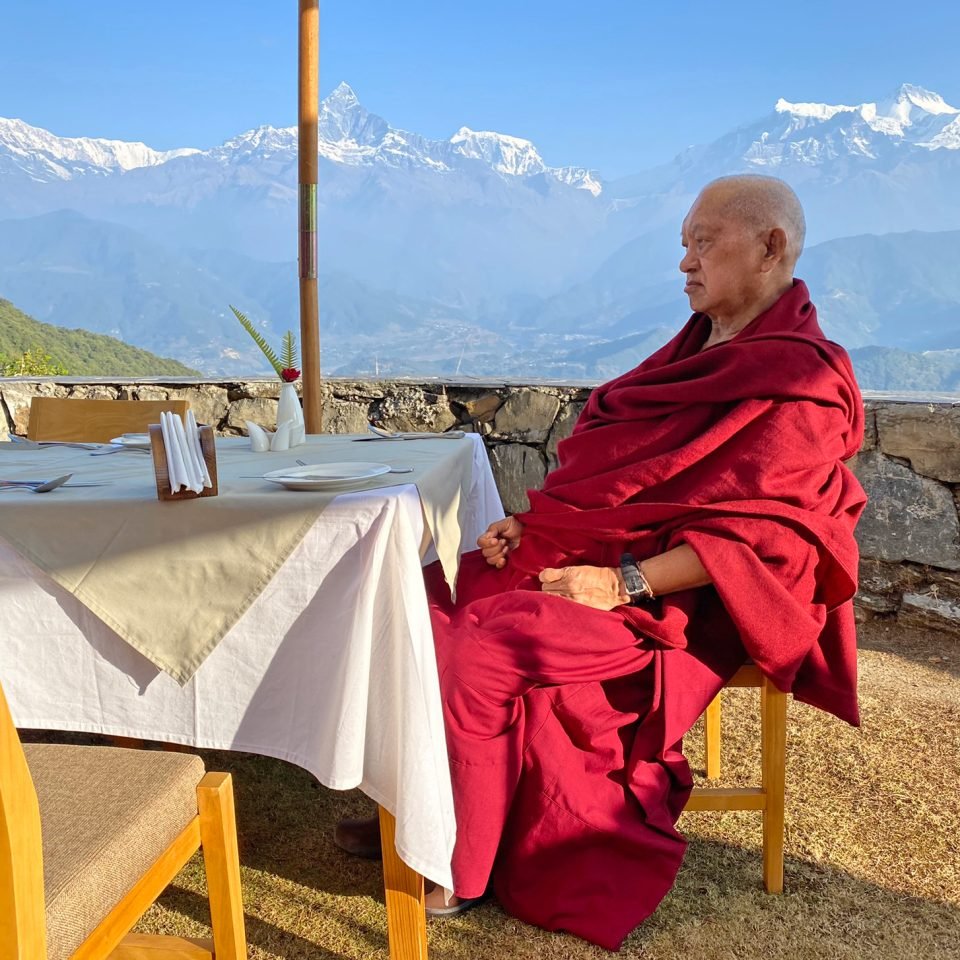
Lama Zopa Rinpoche with views of Annapurna and the Himalayan Mountains, Pokhara, Nepal, December 2021. Photo by Ven. Roger Kunsang.
We can engage in many beneficial activities with our perfect human rebirth. Those activities include generating the four immeasurable thoughts, overcoming self-cherishing, living life with a good heart, and cherishing others. Here are short summaries of Rinpoche’s teachings on these beneficial activities from “The Time to Practice is Now,” a detailed overview of the 2020 Thought Transformation Teachings given by Rinpoche. A short video of Rinpoche teaching on this topic follows the excerpt.
We Can Use Our Perfect Human Rebirth to Generate the Four Immeasurable Thoughts
This perfect human rebirth is so precious because it can be used to practice the four immeasurable thoughts. The merit of practicing each of the four immeasurable thoughts—immeasurable equanimity, immeasurable loving kindness, immeasurable compassion, and immeasurable joy—is so huge that it doesn’t fit in the sky. Rinpoche advises us to not just recite the words of the prayer for generating the four immeasurable thoughts—while thinking of eating pizza or going to the beach!—but to actually meditate on them. To illustrate the benefits of doing so, Rinpoche talks extensively about the benefits of generating immeasurable loving kindness. For example, King of Concentration Sutra says that the merit of generating loving kindness far exceeds the merit of making unimaginable offerings to all the supreme holy beings in ten million billion universes! Meditation on the four immeasurables combined with doing tonglen is especially amazing.
We Can Use Our Perfect Human Rebirth to Overcome Self-Cherishing
This perfect human rebirth is also so precious because we can use it to overcome our self-cherishing thought, our selfish mind, and generate loving kindness, compassion, and bodhicitta. This is much more meaningful than living our life under the control of delusions and causing harm to sentient beings. Usually when someone harms us, our solution is to harm them back, and because of this, we continuously receive harm. The self-cherishing thought that thinks, “I am most important, my happiness is most important,” is a total hallucination. It is like drinking poison while believing it is nectar and only causes us to harm ourselves and others.
The self-cherishing mind is also like a rock. We have to make it soft like cotton—full of loving-kindness and great compassion for others—which leads to bodhicitta. In addition, the self-cherishing mind is like a dictator which only thinks about our own happiness and our own power. We don’t want anyone to harm us or be displeased with us. Because of that, if someone harms, insults, or criticizes us, we get so upset because the self-cherishing mind didn’t get what it wanted. This self-cherishing is the real enemy because all of the suffering of samsara from beginningless rebirths up until now comes from thinking in this way. Together with self-grasping, it has prevented us from achieving even one realization of the path to enlightenment and from liberating even one single sentient being from samsara.
Living our life controlled by the self-cherishing thought, anger, attachment, and the root of samsara—the ignorance holding the I as real—has cheated us. We think of “me, me, me” and work only for ourselves, but all of our happiness comes from sentient beings. Also, Buddha, Dharma, and Sangha, in whom we take refuge, come from sentient beings. Therefore, we should see all sentient beings as dear and use this precious opportunity of a human life to abandon self-cherishing and strengthen the mind that cherishes others more than ourselves.
We Can Use Our Perfect Human Rebirth to Live Life with a Good Heart and Cherish Others
It is so important to live our life with a good heart, not harming sentient beings and only benefiting them. First we come to realize that everyone’s happiness is as important as our own; and next we come to realize that their happiness is more important than our own.
There are many benefits of using our precious human rebirth to cherish others. If we want happiness, it has to come from our mind, Rinpoche explains. Buddha defeated a million maras by meditating on loving-kindness. If we practice loving-kindness, if we practice bodhicitta, this is the best protection from life’s dangers. If we don’t want suffering—don’t harm others! If a person dedicates their life and offers service with a good heart to everyone, not in a forced way but happily and sincerely, then everything appears to that person as happy, everything appears as good. Therefore, it is also in our own self-interest to cherish others.
Generating loving kindness and compassion, and avoiding the self-cherishing mind is also unbelievably important for our health. With a good heart, we can achieve success for ourselves and others. We can cease all the wrong concepts and delusions,
Watch the Essential Extract “You Get Skies of Merits by Meditating on Immeasurable Loving Kindness”:
In this short video Essential Extract, Lama Zopa Rinpoche explains that our perfect human rebirth is precious because we can use it to generate loving kindness. Rinpoche then recites the short prayer for generating loving kindness and explains its significance. As Rinpoche says, “Even generating loving kindness just for a very short time, a few seconds or a minute, wow, wow, wow, amazing, amazing, wow, wow, the benefits, the merits that you get, wow, wow.” However, if we don’t understand this, we won’t like doing prayers and instead will spend our life involved in negative karma.
Read the transcript of this video extract from Rinpoche’s teaching:
https://fpmt.box.com/s/dfc9e1a70z2rqmmbhh7dufeddfl22cl7
You can find more blogs with short video clips from Rinpoche’s teaching as well as the complete collection of these “Essential Extracts” videos on FPMT.org.
Read more on this topic in Lama Zopa Rinpoche’s book The Perfect Human Rebirth: Freedom and Richness on the Path to Enlightenment, published by Lama Yeshe Wisdom Archive (LamaYeshe.com). You can find the four immeasurable thoughts in the Daily Prayers booklet, available in ebook and PDF format in the Foundation Store (shop.fpmt.org).
Lama Zopa Rinpoche is the spiritual director of the Foundation for the Preservation of Mahayana Tradition (FPMT), a Tibetan Buddhist organization dedicated to the transmission of the Mahayana Buddhist tradition and values worldwide through teaching, meditation and community service.
- Tagged: advice from lama zopa rinpoche, essential extract, essential extract thought transformation teachings, perfect human rebirth, video
8
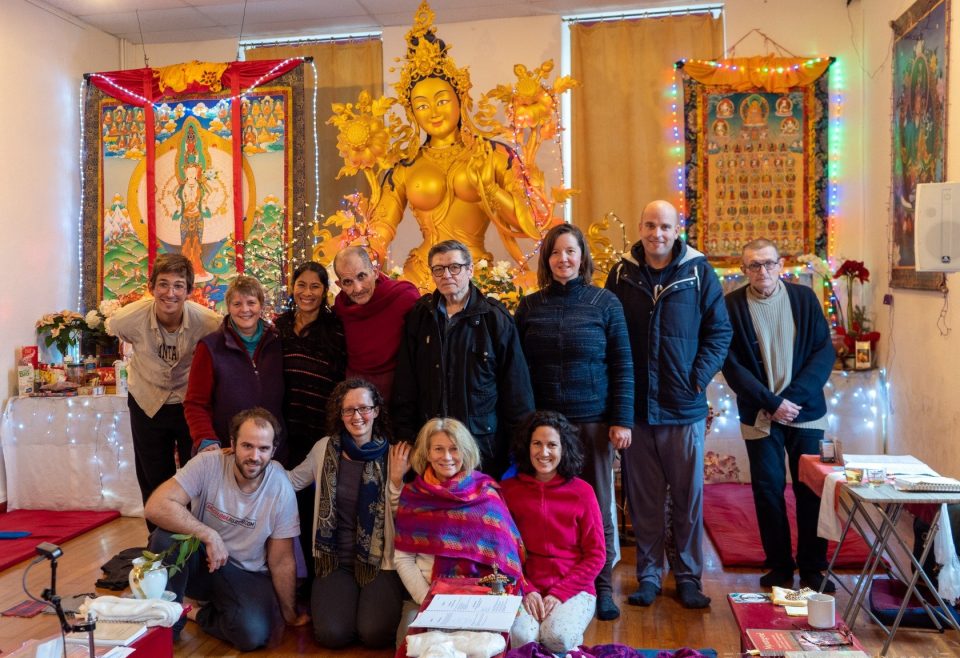
Some of the 2021-2022 nyung-na retreat participants at IVY. Photo by Tsanka Petkova
Institut Vajra Yogini (IVY), France, began hosting their eleventh 108 Nyung-Na Retreat in November 2021. Despite precautions taken before the start of the retreat, and adhering to local protocols once the retreat began, in January one retreatant tested positive for the coronavirus. Then each participant became sick one by one, and the virus spread to the wider IVY community as well.
The nyung-nas were paused upon learning about the spread among retreatants. After two weeks and negative tests from all participants, the retreat began again on January 31. Only eight nyung-nas were missed during this break, and some retreatants may still complete one hundred nyung-nas during this 2021-2022 series. The continuity of this seven month series of 108 nyung-nas was not broken as one of the retreatants managed to continue the practice alone during the break. Please rejoice!
Lama Zopa Rinpoche sent the IVY community advice on how to use the virus to attain enlightenment. This is timely advice for students around the world who are still dealing with the negative effects of this pandemic:
My most dear, most precious, treasure of Vajrayogini, Geshe Loden Rinpoche, and then my most dear, all the Vajrayogini brothers and sisters, everybody who are in the Vajrayogini mandala,
So Geshe Loden explained everyone got this very precious virus.
So I want to mention what Kadampa Geshe Khamlungpa said: Even this present little suffering, it finishes the past heavy negative karmas, and in the future will turn out happiness. Therefore rejoice, be happy that you are experiencing this suffering.
Therefore, you received the virus, so be happy—happy, hippie, not hippie, happy, hippie already years ago. I am bringing back hippie life now.
So the benefits are incredible. By experiencing this now, it finishes so many heavy negative karmas, from so many past lives. Wow! Can you imagine from beginningless rebirth, so many heavy negative karmas? It makes to finish them, so that is the benefit.
Otherwise, you have to be in the lower realm, and for eons and eons you have to suffer in the cold hells, in the hot hells, all those major and secondary hells. Wow, wow, wow, wow, wow, wow, wow! Can you imagine?
So this experience, this virus, it makes to finish all the past heavy negative karma. So what happens in the future is that you will be like the sun shining in the world. So, everybody, people, animals, enjoy the sun rising in the whole world. Then there will be so much happiness. From life-to-life you will go to enlightenment.
Then, there are many other benefits from experiencing suffering. There are many other benefits, but I just mention this much.
The other most important thing you have to know is that bad and good is not outside. It is up to your mind; whatever happens in your life, bad or good, is up to your mind. Like when you change the TV channel, there is fighting, then there are people having a party, people singing, dancing, trying to show enjoying—they think it is real pleasure. Then there’s fighting, people crying, wow, wow, wow, wow, more wars. So whether it’s bad or good, it is up to the mind, how one thinks, how the mind uses the virus. So, it is like that.
So, any suffering you have, relationship problems, or anything, you use that. Like the quotation I mentioned above. Then it is positive, then having the problem is positive, that is so good.
So then of course, by cherishing I, then attachment, then you suffer—wow, wow, wow, wow, wow, wow, suffer, suffer, suffer—it’s like that.
Then I want to mention one thing: the self-cherishing thought has been harming you. You have been following the self-cherishing thought, oneself under the control of self-cherishing from beginningless lives, not just from this birth, not from this morning, not from birth, but from beginningless rebirths. So, you’ve been cheating yourself, harming yourself from beginningless rebirth, and you’ve been suffering from beginningless rebirth in samsara.
Then again you will suffer without end. Without practicing bodhicitta, but by following the self-cherishing thought, you will suffer, and you will experience the suffering in samsara without end. So, that’s the problem.
Then not only that, you see yourself as so precious, wow, but it is so harmful. So now you think of others, the numberless sentient beings—numberless hell beings, who are so precious, like yourself; numberless hungry ghosts, who are so precious, like yourself; numberless animals, like the ants, the mosquitoes, who are so precious, like yourself; and numberless human beings, who are so precious, like yourself. Then there are the numberless suras, asuras, and intermediate state beings, who are so precious, like yourself. Wow!
Then being under the control of the self-cherishing thought, because of not practicing with bodhicitta, all the sentient beings from the six realms have been harmed, and they have been suffering in samsara from beginningless rebirth, so it already happened.
So then, if you don’t practice bodhicitta, don’t actualize bodhicitta, then you don’t meet Dharma. If you don’t meet Dharma, wow, wow, wow, then not only do you suffer in samsara without end, but then you cause the sentient beings to suffer. You harm all the sentient beings, then they suffer, numberless, without end, they suffer in samsara without end, again, wow, wow, wow, wow, wow, wow.
Even if you cause just one sentient being like this to suffer, it is an incredible thing how bad the self-cherishing thought is, how harmful, how it is the worst enemy, wow, wow, wow, wow.
So now sentient beings are numberless. So the virus is not harming, but helping you, because the virus is destroying your self-cherishing thought; the virus is harming your self-cherishing thought. That’s what you have to know. You must recognize that.
By destroying the self-cherishing thought, then it is possible to have bodhicitta and that makes to achieve enlightenment, and then to finish all the obscurations, the mistakes, then to complete all the qualities. And then after that, you liberate the numberless sentient beings from the samsara. Wow, wow, wow, wow!
And then after that, you bring them to enlightenment. Wow, wow! So that all comes from you achieving enlightenment, all that comes from bodhicitta. Wow!
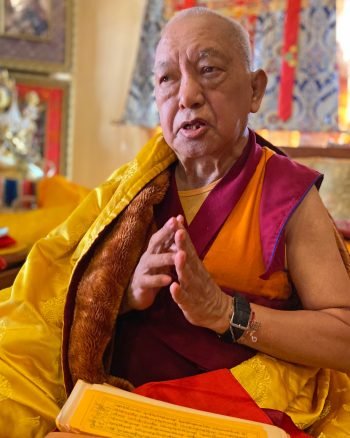
Lama Zopa Rinpoche at Kopan Monastery, January 2022. Photo by Ven. Roger Kunsang.
So you have to look at it that way: the virus is helping you. It becomes the most precious, like a treasure, the most precious wish-granting jewel, so very precious.
In Tibetan we have 424 diseases, and then 360 spirit possessions and 84,000 interferers.
So then there’s no question about this virus. So there are all those things, which are kind of harmful, but everything is transformed. If you think in this way, then everything is supportive for you to achieve enlightenment, and there are no obstacles in your life.
Therefore, the virus is so supportive for you to achieve enlightenment by destroying the self-cherishing thought. So it is like that.
Therefore, you have no obstacles in the life. All the obstacles that you have in your life, the obstacles to practice Dharma, they all become the path to enlightenment. So, there’s no obstacles in the life.
This is how to enjoy the sufferings, or obstacles. That is lojong, the key lojong. It is a very, very, very important lojong point. So try as much as possible, try as much as possible.
So then there are mantras to recite, but you try this, lojong. We need to achieve enlightenment for sentient beings, so we use the obstacles, we utilize them in the path to enlightenment.
So, do lojong as much as possible because our mind is not well trained in lojong. Those who have trained well in lojong, their mind is so happy. How much suffering there is, how much suffering there is wow! So the more suffering there is, the mind is more happy, blissed out.
So since many of us are beginners, try as much as possible to develop this.
Then recite Vajra Armor mantra, Geshe Loden will know it, and it is online. Then recite Black Manjushri mantra.
Thank you very much! See you soon.
With much love and prayers,
Lama Zopa
Colophon: Advice dictated by Lama Zopa Rinpoche at Kopan Monastery, Nepal. Transcribed by Ven. Thubten Munsel, January 21, 2022. Lightly edited by Ven. Holly Ansett and Laura Miller.
Rinpoche has offered extensive valuable advice for practices to be done during the pandemic.
You can find more blogs with short video clips from Rinpoche’s teaching as well as the complete collection of these “Essential Extracts” videos on FPMT.org.
Lama Zopa Rinpoche is the spiritual director of the Foundation for the Preservation of Mahayana Tradition (FPMT), a Tibetan Buddhist organization dedicated to the transmission of the Mahayana Buddhist tradition and values worldwide through teaching, meditation and community service.
2
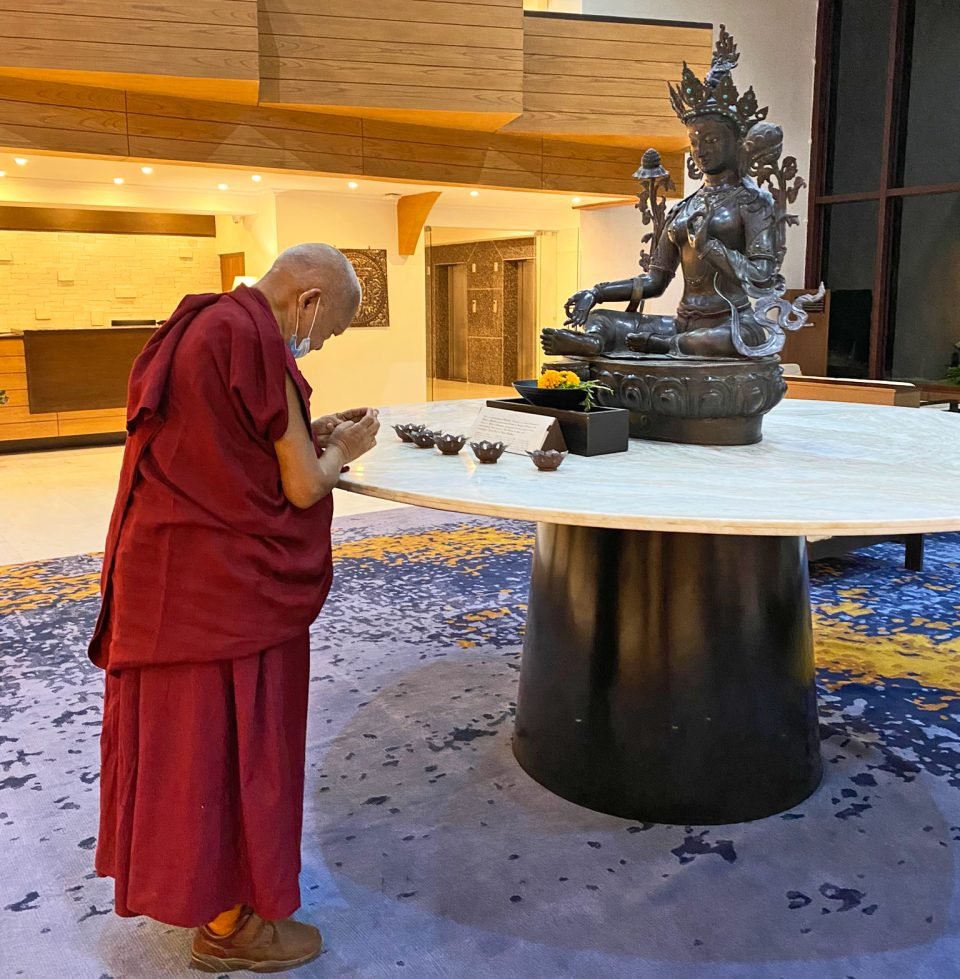
Lama Zopa Rinpoche making prayers to a Tara statue in a hotel in Pokhara, Nepal, December 2021. Photo by Ven. Roger Kunsang.
We can engage in many beneficial activities with our perfect human rebirth, including finding and correctly following a virtuous friend who can guide us to enlightenment. As Lama Zopa Rinpoche teaches, following the guru’s advice is the quickest way to become free from the oceans of samsaric sufferings and achieve enlightenment. Here is an excerpt on this topic from “The Time to Practice is Now,” a detailed summary of the 2020 Thought Transformation Teachings given by Rinpoche. A short Essential Extract video of Rinpoche teaching on following the guru comes after the excerpt.
With this perfect human rebirth we can find a guru, a virtuous friend, who can guide us to enlightenment. Once we have identified someone who possesses the necessary qualities, it is important to correctly follow that guru. To do this, we need to transform our ordinary thought that sees the guru as a normal being into a pure devotional thought that sees the guru as a buddha. This involves a total transformation of our mind that allows us to receive the blessings of the buddhas and gain the realizations of the path to enlightenment. As Rinpoche says, all the holy actions of the buddhas manifest in the guru and every atom of the guru is the numberless buddhas. Thus, correctly following the guru is the quickest way to become free from the oceans of samsaric sufferings and achieve enlightenment.
Unless we have omniscience or very high clairvoyance, we aren’t able to see others’ minds and we can’t tell who is enlightened. The buddhas take different forms to benefit sentient beings depending on the mind of the being. Because at the moment our mind is so obscured, we cannot see a buddha in the aspect of a buddha. The only way we can see the guru is in human form with an ordinary aspect—as having delusions and showing mistaken actions. This is currently the only way for the guru to guide us.
Therefore, when we see mistakes in our guru’s actions, we should think that the guru is purposely showing us the aspect of mistakes because our mind is so obscured and defiled that if the guru didn’t show themselves in this way, we wouldn’t be able to see or communicate with them, and therefore we wouldn’t be able to receive vows, teachings, and so forth from them. In this way, the guru is kinder than all the buddhas for manifesting in an ordinary aspect. Actually, we are fortunate even to have enough good karma to be able to see the guru in human form, rather than as a donkey or mouse! The guru’s kindness is like the limitless sky.
Rinpoche goes over the eight benefits of correctly following the virtuous friend and the eight shortcomings of not doing so. (See chapter 8 in Liberation of the Palm of Your Hand.) We need to understand these well because when our guru is sweet and speaks nice words to us, or gives us presents, we are happy and pleased with them. But if our guru scolds us or shows they are displeased with us, our tendency is to give them up, to throw them away like garbage. Rinpoche asks, How can we achieve enlightenment if we give up the guru when the guru does something that our self-cherishing thought doesn’t like? Instead, we should remember the eight benefits and shortcomings and keep our devotion strong and stable. We should also remember that when the guru scolds us, all the buddhas are scolding us.
A Buddha cannot have anger, it is not possible, so they do this to help purify our negative karma. Likewise, when the guru is praising us, we should rejoice thinking that all the buddhas are so pleased with us.
Rinpoche gives the example of Milarepa, who became enlightened, not only in one life, but in a brief lifetime of degenerate times through the extreme hardships he endured under the guidance of his teacher Marpa. To the outside it looked like he was the most unfortunate person: kicked out of teachings, scolded, and even beaten; but, internally, his bearing these difficulties caused the strongest purification and became the quickest way for him to achieve enlightenment. In fact, when we bear hardships by following our guru’s advice or to fulfill their wishes, it is equivalent to doing the preliminary practices many hundreds of thousands of times. Even if the work is very hard and fraught with problems and difficulties, it becomes something to enjoy the most because it creates the same purification as having done many hundreds of thousands of prostrations, Vajrasattva mantras, mandala offerings, and so forth. It is most amazing.
If we are following the guru’s advice and get sick or experience problems, this is a very good sign because it means many, many eons of suffering in the lower realms are now being purified. Every second that we fulfill the guru’s wishes and follow their advice, our negative karma is being burned up and we are collecting skies of good karma. How much purification happens and how much merit we collect depends entirely on how well we practice correctly following the virtuous friend.
Conversely, if we don’t know the practice of correctly following the guru, we will create the heaviest negative karma every minute. If we disrespect our guru, it becomes disrespect to all the buddhas. After we decide to become a disciple of the guru, if we then belittle the guru, we cannot achieve enlightenment in this life, Rinpoche explains. As such, it is a very heavy negative karma that results in the worst suffering. Therefore, a serious practitioner makes their mind strong and does not allow anything to distract them. No matter what happens they remain determined to fulfill the guru’s wishes and to follow the guru’s advice in order to achieve enlightenment for all sentient beings. Correctly following the virtuous friend becomes the most important thing in one’s life! This is why we must choose our guru very wisely.
To inspire us to correctly follow our guru, Rinpoche explains that by offering service to the guru, we receive more merit than if we were to make offerings to numberless buddhas, Dharma, and Sangha! Even a small gesture like offering a cup of water or a pair of shoes to the guru creates more merit than making offerings to numberless Buddha, Dharma, Sangha, and statues, stupas, and scriptures.
Also, by correctly following the guru, we create the cause to meet a qualified guru in this and all future lifetimes, and to receive the complete and unmistaken Dharma teachings from them. Every second we correctly follow the guru, we create the causes to receive a higher rebirth, and, ultimately, to put an end to the sufferings of samsara and achieve enlightenment. By depending on the guru, we can even achieve enlightenment in a brief lifetime of degenerate times. It is said that even the most foolish person can do this through strong and stable devotion. It is only our lazy mind that makes it difficult to follow the guru’s advice, Rinpoche explains. But by seeing the guru as all the buddhas, and by remembering the guru’s kindness, which is like the limitless sky, we become so happy to follow the advice because we see the incredible importance and the great benefits. So we must make good use of this opportunity!
In this short video Essential Extract, Lama Zopa Rinpoche explains that when we experience difficulties in doing as our guru advised, such as keeping our vows, doing retreat, or working for a center or the FPMT organization, we should know that it is like doing hundreds of thousands of prostrations or mandala offerings. By bearing these hardships, we are purifying our negative karma and collecting extensive merits, which we need to do in order to achieve enlightenment. On the other hand, if we don’t continuously keep our mind in devotion and allow heresy to arise, our mind becomes suffering, like popcorn popping, tak, tak, tak, tak, and we are creating the cause of hell.
Read the transcript of this video extract from Rinpoche’s teaching:
https://fpmt.box.com/s/thhps12d38cky0be88feafj6mzd208fn
You can find more blogs with short video clips from Rinpoche’s teaching as well as the complete collection of these “Essential Extracts” videos on FPMT.org.
Lama Zopa Rinpoche is the spiritual director of the Foundation for the Preservation of Mahayana Tradition (FPMT), a Tibetan Buddhist organization dedicated to the transmission of the Mahayana Buddhist tradition and values worldwide through teaching, meditation and community service.
- Home
- News/Media
- Study & Practice
- About FPMT Education Services
- Latest News
- Programs
- New to Buddhism?
- Buddhist Mind Science: Activating Your Potential
- Heart Advice for Death and Dying
- Discovering Buddhism
- Living in the Path
- Exploring Buddhism
- FPMT Basic Program
- FPMT Masters Program
- FPMT In-Depth Meditation Training
- Maitripa College
- Lotsawa Rinchen Zangpo Translator Program
- Universal Education for Compassion & Wisdom
- Online Learning Center
- Prayers & Practice Materials
- Overview of Prayers & Practices
- Full Catalogue of Prayers & Practice Materials
- Explore Popular Topics
- Benefiting Animals
- Chenrezig Resources
- Death & Dying Resources
- Lama Chopa (Guru Puja)
- Lama Zopa Rinpoche: Compendium of Precious Instructions
- Lama Zopa Rinpoche: Life Practice Advice
- Lama Zopa Rinpoche Practice Series
- Lamrim Resources
- Mantras
- Prayer Book Updates
- Purification Practices
- Sutras
- Thought Transformation (Lojong)
- Audio Materials
- Dharma Dates – Tibetan Calendar
- Translation Services
- Publishing Services
- Teachings and Advice
- Find Teachings and Advice
- Lama Zopa Rinpoche Advice Page
- Lama Zopa Rinpoche: Compendium of Precious Instructions
- Lama Zopa Rinpoche Video Teachings
- ༧སྐྱབས་རྗེ་བཟོད་པ་རིན་པོ་ཆེ་མཆོག་ནས་སྩལ་བའི་བཀའ་སློབ་བརྙན་འཕྲིན།
- Podcasts
- Lama Yeshe Wisdom Archive
- Buddhism FAQ
- Dharma for Young People
- Resources on Holy Objects
- Ways to Offer Support
- Centers
- Affiliates Area
- Teachers
- Projects
- Charitable Projects
- Make a Donation
- Applying for Grants
- News about Projects
- Other Projects within FPMT
- Support International Office
- Projects Photo Galleries
- Give Where Most Needed
- FPMT
- Shop
Translate*
*powered by Google TranslateTranslation of pages on fpmt.org is performed by Google Translate, a third party service which FPMT has no control over. The service provides automated computer translations that are only an approximation of the websites' original content. The translations should not be considered exact and only used as a rough guide.Without the practice of morality, there’s no enlightenment, no liberation from samsara, not even good rebirths in future lives.







